Conducting Research With Our Users
02
03
A simple and intuitive journey creation process is essential — implementing a chatbot with AI instead of a traditional form would significantly improve usability
Personalization aided by AI boosts participation — striking a balance between manually creating a journey and creating it with AI is important
I also conducted 7+ semi-structured interviews with librarians of the Health Sciences Library to learn about their pain points and desires.
01
AI is seen as robotic and impersonal — naming the AI assistant and chatting with it can create a sense of familiarity and trust

Homepage is very overwhelming and cluttered — more portals and a more simple design
would be helpful
Personalization aided by AI boosts participation — striking a balance between manually creating a journey and creating it with AI is important
AI is seen as robotic and impersonal — naming the AI assistant and chatting with it can create a sense of familiarity and trust


Conducting Research With Our Users
02
03
A simple and intuitive journey creation process is essential — implementing a chatbot with AI instead of a traditional form would significantly improve usability
Personalization aided by AI boosts participation — striking a balance between manually creating a journey and creating it with AI is important
We conducted discussions with four professionals across various healthcare specialties to grasp a comprehensive understanding of users' needs from an application that supports them in managing their patients’ progress. We learned about their practices for patient data input and monitoring, doctor collaboration, and personalized journey creation, along with the difficulties they encountered in building personalized patient plans.
01
AI is seen as robotic and impersonal — naming the AI assistant and chatting with it can create a sense of familiarity and trust

Conducting Research With Our Users
02
03
A simple and intuitive journey creation process is essential — implementing a chatbot with AI instead of a traditional form would significantly improve usability
Personalization aided by AI boosts participation — striking a balance between manually creating a journey and creating it with AI is important
We conducted discussions with four professionals across various healthcare specialties to grasp a comprehensive understanding of users' needs from an application that supports them in managing their patients’ progress. We learned about their practices for patient data input and monitoring, doctor collaboration, and personalized journey creation, along with the difficulties they encountered in building personalized patient plans.
01
AI is seen as robotic and impersonal — naming the AI assistant and chatting with it can create a sense of familiarity and trust

We conducted discussions with four professionals across various healthcare specialties to grasp a comprehensive understanding of users' needs from an application that supports them in managing their patients’ progress. We learned about their practices for patient data input and monitoring, doctor collaboration, and personalized journey creation, along with the difficulties they encountered in building personalized patient plans.
For this redesign, I conducted 20+ semi-structured interviews with students using the Health Sciences
Library to learn about what they used the website for and their pain points when using the website.
LifePattern AI
LifePattern AI
Harnessing Artificial Intelligence to Optimize Personal Health Journeys
Harnessing Artificial Intelligence to Optimize Personal Health Journeys




Overview
Role
Context
Context
Problem
Duration
Duration
Tools
UX Designer
UX Designer
Dec. 2023 — June 2024
Dec. 2023 — June 2024
Miro, Figma
The healthcare industry faces numerous challenges, including long waiting times for consultations, high costs of appointments and treatments, and a lack of personalized medical attention. LifePattern AI is a healthcare technology platform that leverages artificial intelligence to provide personalized and data-driven healthcare solutions.
Solution
LifePattern AI's main goal is to improve patient outcomes and experiences by creating personalized healthcare journeys using artificial intelligence. Users have reported that the process of building a healthcare journey is complicated and time-consuming, resulting in low conversion rates.
Increase conversion rates and improve customer satisfaction by simplifying the process with a more intuitive design, offering step-by-step guidance and reducing the number of steps required.
LifePattern AI's main goal is to improve patient outcomes and experiences by creating personalized healthcare journeys using artificial intelligence. Users have reported that the process of building a healthcare journey is complicated and time-consuming, resulting in low conversion rates.
LifePattern AI's main goal is to improve patient outcomes and experiences by creating personalized healthcare journeys using artificial intelligence. Users have reported that the process of building a healthcare journey is complicated and time-consuming, resulting in low conversion rates.
Increase conversion rates and improve customer satisfaction by simplifying the process with a more intuitive design, offering step-by-step guidance and reducing the number of steps required.
Miro, Figma
Context
Problem
The healthcare industry faces numerous challenges, including long waiting times for consultations, high costs of appointments and treatments, and a lack of personalized medical attention. LifePattern AI is a healthcare technology platform that leverages artificial intelligence to provide personalized and data-driven healthcare solutions.
LifePattern AI's main goal is to improve patient outcomes and experiences by creating personalized healthcare journeys using artificial intelligence. Users have reported that the process of building a healthcare journey is complicated and time-consuming, resulting in low conversion rates.
Solution
Increase conversion rates and improve customer satisfaction by simplifying the process with a more intuitive design, offering step-by-step guidance and reducing the number of steps required.
The healthcare industry faces numerous challenges, including long waiting times for consultations, high costs of appointments and treatments, and a lack of personalized medical attention. LifePattern AI is a healthcare technology platform that leverages artificial intelligence to provide personalized and data-driven healthcare solutions.
LifePattern AI's main goal is to improve patient outcomes and experiences by creating personalized healthcare journeys using artificial intelligence. Users have reported that the process of building a healthcare journey is complicated and time-consuming, resulting in low conversion rates.
Increase conversion rates and improve customer satisfaction by simplifying the process with a more intuitive design, offering step-by-step guidance and reducing the number of steps required.
Figma
The healthcare industry faces numerous challenges, including long waiting times for consultations, high costs of appointments and treatments, and a lack of personalized medical attention. LifePattern AI is a healthcare technology platform that leverages artificial intelligence to provide personalized and data-driven healthcare solutions.
LifePattern AI's main goal is to improve patient outcomes and experiences by creating personalized healthcare journeys using artificial intelligence. Users have reported that the process of building a healthcare journey is complicated and time-consuming, resulting in low conversion rates.
Increase conversion rates and improve customer satisfaction by simplifying the process with a more intuitive design, offering step-by-step guidance and reducing the number of steps required.
Conducting Research With Our Users
We conducted discussions with four professionals across various healthcare specialties to grasp a comprehensive understanding of users' needs from an application that supports them in managing their patients’ progress. We learned about their practices for patient data input and monitoring, doctor collaboration, and personalized journey creation, along with the difficulties they encountered in building personalized patient plans.
We uncovered 3 main findings:
Build Trust with AI
Create a more trusting and familiar experience by naming the AI assistant
Create a more trusting and familiar experience by naming the AI assistant
Intuitive
Simplify the journey creation process, no more submitting length forms
Personalization
Strike a balance between manually creating a journey and personalizing your journey with AI
Personalization
Strike a balance between manually creating a journey and personalizing your journey with AI
Build Trust with AI
Create a more trusting and familiar experience by naming the AI assistant
Create a more trusting and familiar experience by naming the AI assistant
Build Trust with AI
Create a more trusting and familiar experience by naming the AI assistant
Replacing Response Forms with a Chabot
Realizing that our users thought our response forms were monotonous and took too much time, we opted to switch them out for a chatbot. This allowed us to gather ample information from them while also making the experience more individualized and straightforward.
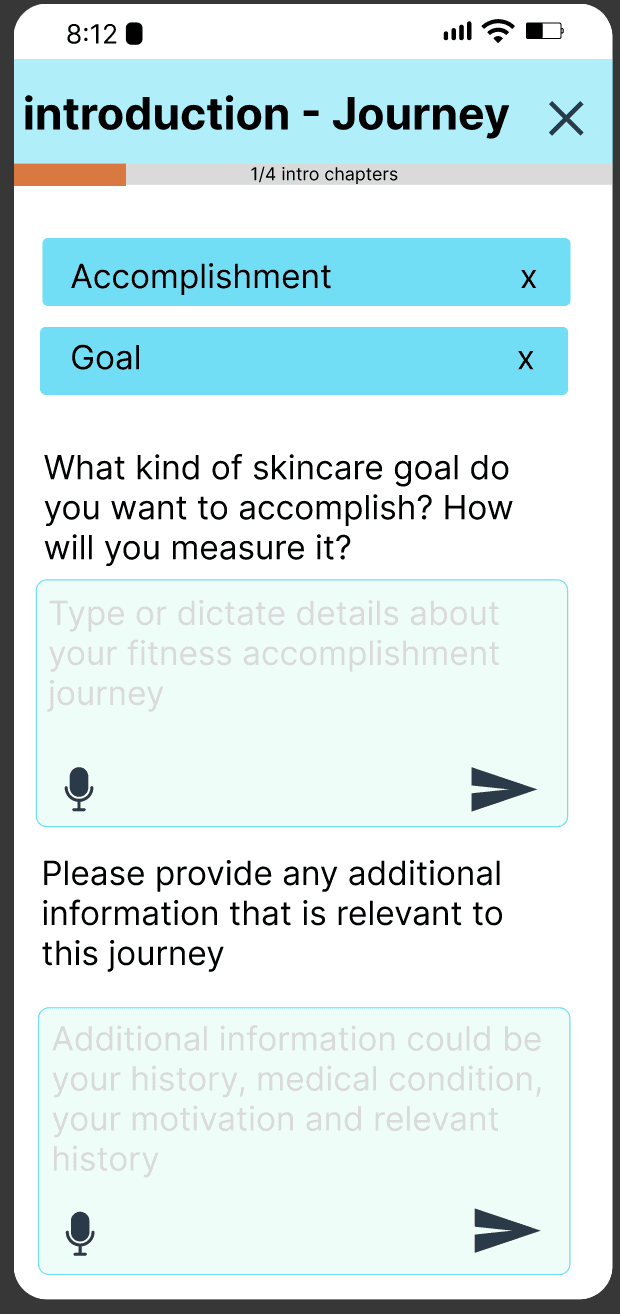

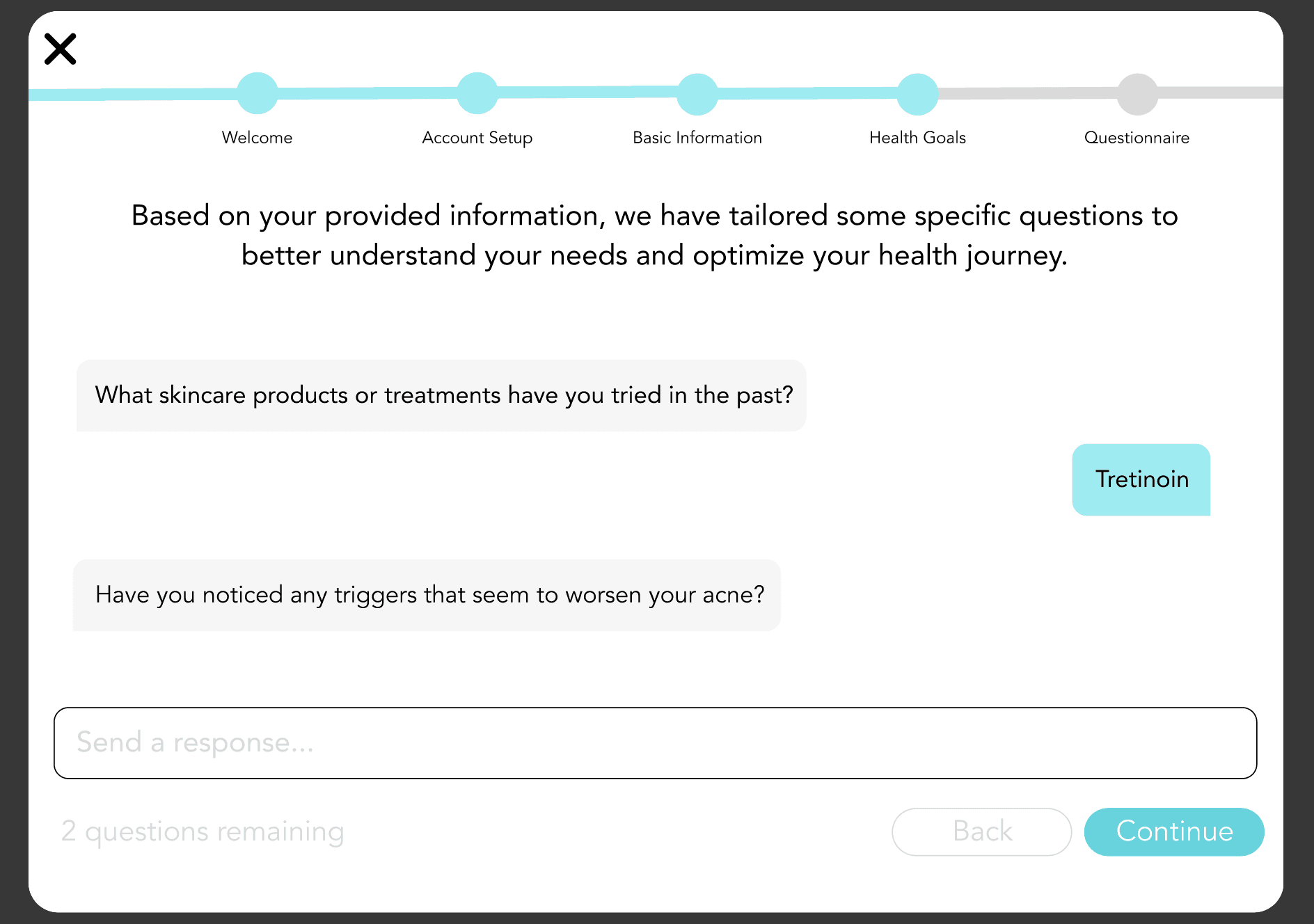

Subsequently, we created user personas loosely influenced by our collaboration findings. One persona is a medical professional who leverage LifePattern.ai to optimize their clinical operation by accessing current patient information, observing health patterns, and communicating with patients and custodians. Another persona represents an individual actively involved in their health regulation and uses the app to monitor daily health indicators, update their journey's progression, and record symptoms or enhancements.


Before
After
Before
After
Designing a New User Journey Flow
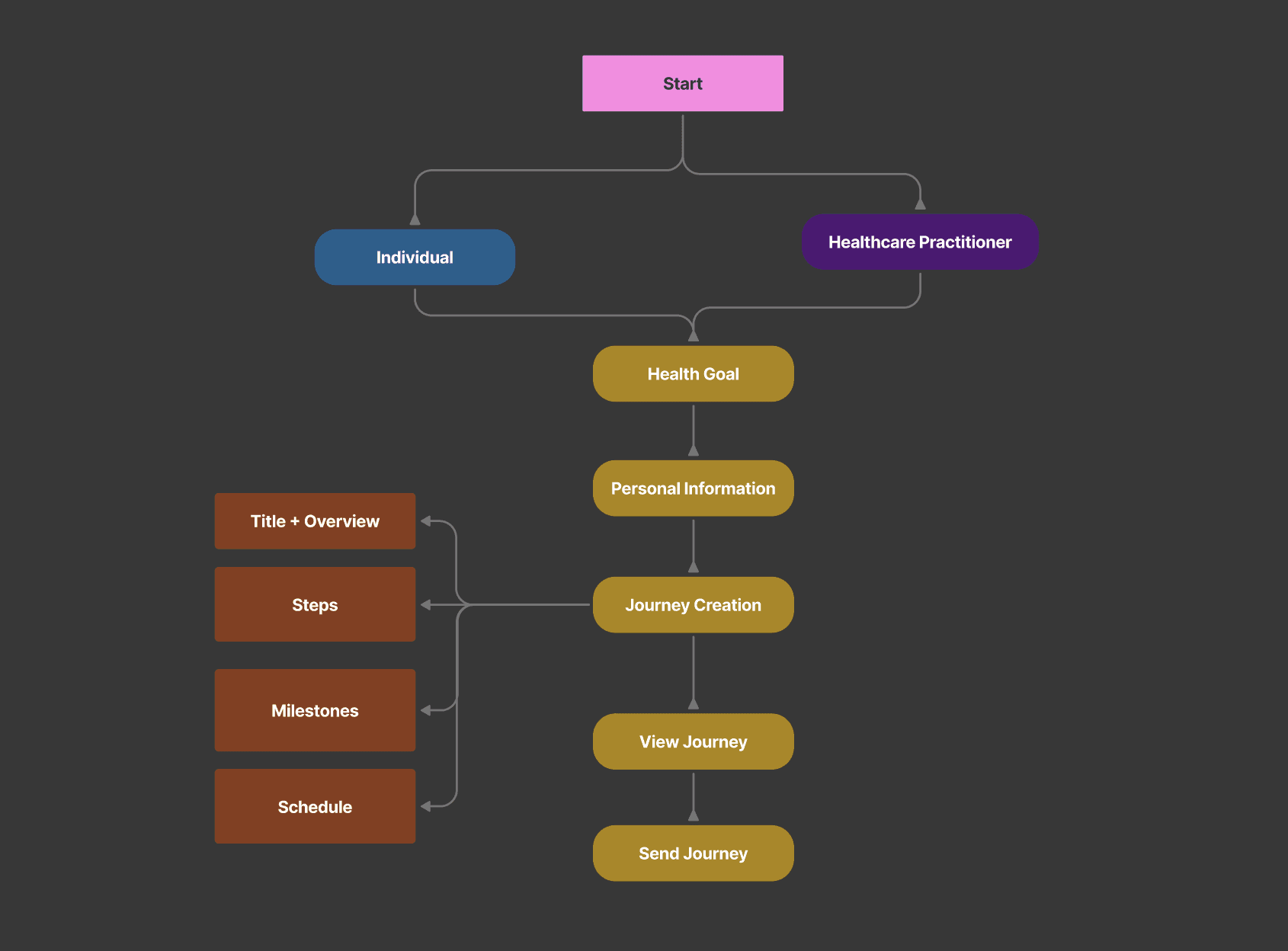
Following discussions with healthcare professionals and individuals dealing with long-term health conditions, we started to build the typical user journey flow for individuals and healthcare practitioners.
Building Wireframes
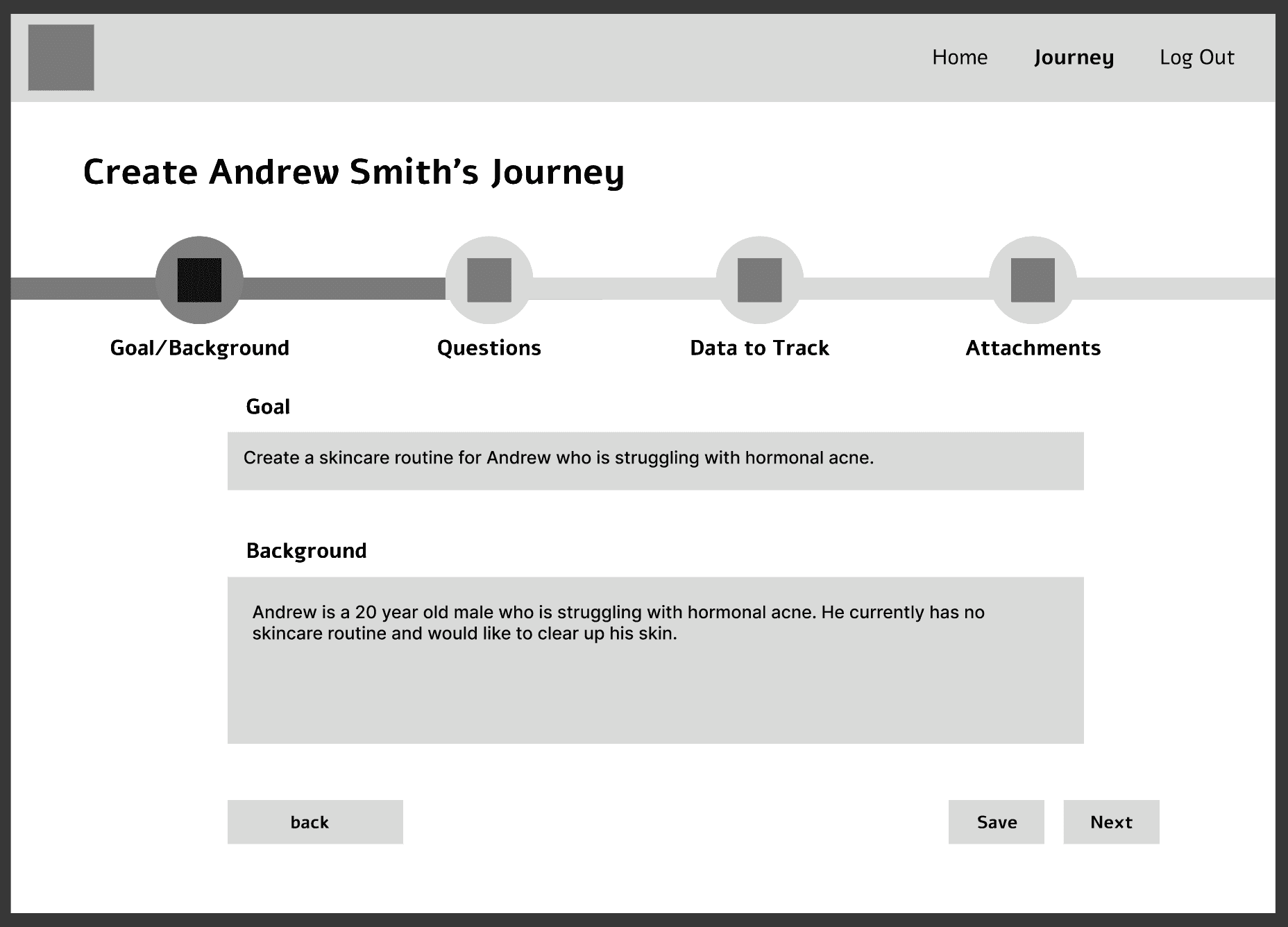
We constructed basic mockups to illustrate the user navigation path. It's similar to the current app of LifePattern AI and features form-oriented input that presents the flow in a stage-by-stage layout.
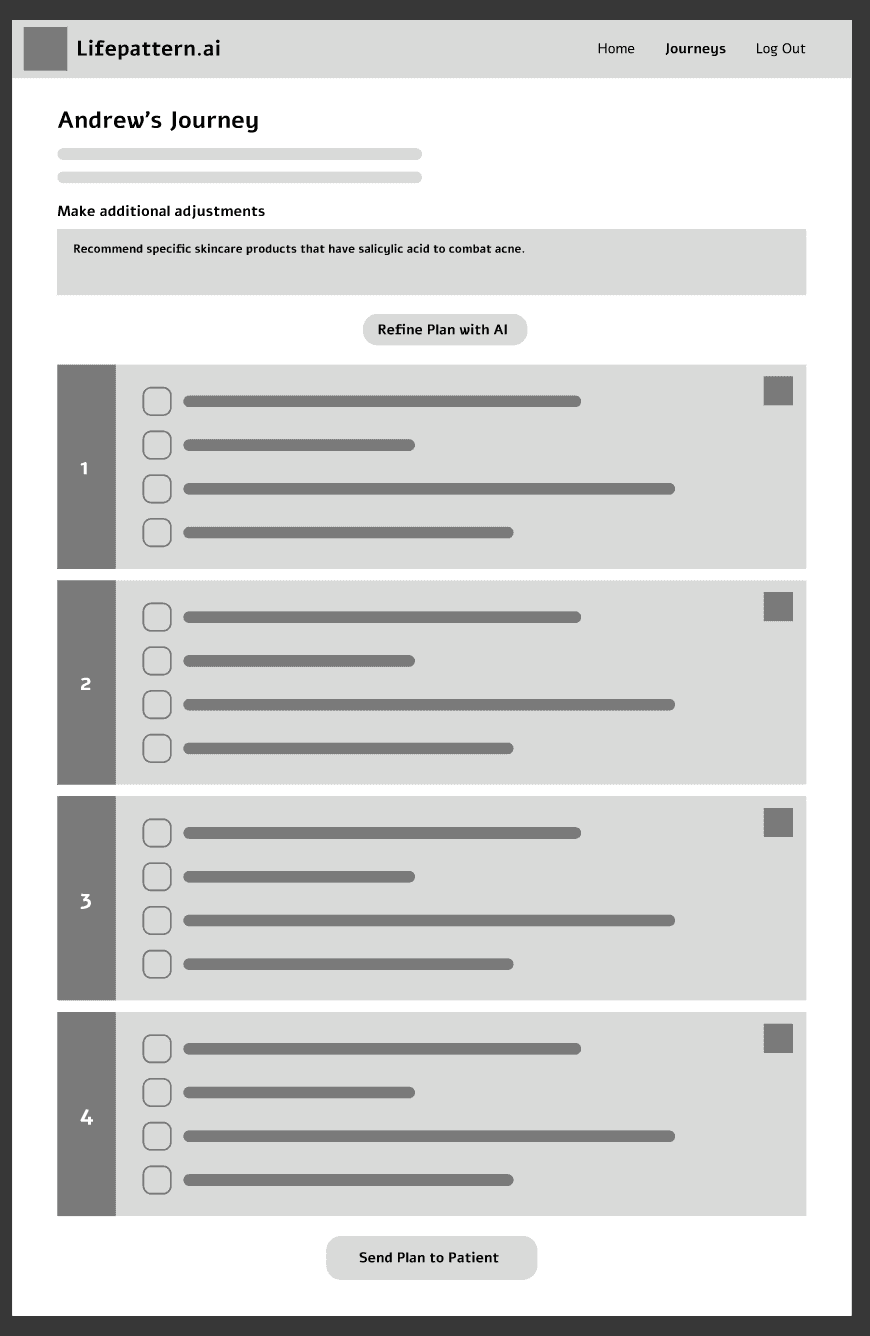


Testing Wireframes
01
02
03
Visibility of System Status — a progress bar is essential for user confidence and navigation
Recognition Rather than Recall — Keeping the milestones visible while editing steps supports user memory and reduces cognitive load.
Error Prevention — Allowing users to skip questions and having the AI provide real-time responses that guide them through the process helps prevent errors
To test the usability of our wireframes, we conducted heuristic evaluations with healthcare practitioners and individuals managing chronic health conditions. We were able to uncover three key areas for future design improvements.
Visibility of System Status — a progress bar is essential for user confidence and navigation
Recognition Rather than Recall — Keeping the milestones visible while editing steps supports user memory and reduces cognitive load.
Error Prevention — Allowing users to skip questions and having the AI provide real-time responses that guide them through the process helps prevent errors
Final Reflection
During my time as a UX Designer for LifePattern AI, I successfully redesigned the Journeys feature for both healthcare practitioners and individuals. As a result, users are able to built their own customizable healthcare journey with assistance from AI in a simple, intuitive way. The biggest obstacle I faced when tackling this project was the lack of resources available my team. We faced much difficulty recruiting participants for user research and user testing and were only able to interview a few healthcare specialists and individuals with chronic conditions. LifePattern AI is also a small company and did not have specialists like UX researchers, AI/healthcare accessibility experts, or content strategists. As a result, my team often had to take on multiple roles such as researchers or strategists which took away from our focus. To overcome this challenge my team and I discussed early on what resources were going to be needed throughout this project, what resources we were lacking, and found solutions to the lack of resources we had early on. This saved us much time and energy later on in our project when we began to struggle with time constraints and lack of knowledge on our project.
One key lesson I gained from this project is the crucial role of advocating for users as a UX designer. Our team primarily collaborated with two developers, and we initially faced significant resistance on several proposed features. Striking a balance between the developers' vision and the users' needs was challenging, but this experience taught me how to effectively communicate my ideas and the rationale behind them.
During my time as a UX Designer for LifePattern AI, I successfully redesigned the Journeys feature for both healthcare practitioners and individuals. As a result, users are able to built their own customizable healthcare journey with assistance from AI in a simple, intuitive way. The biggest obstacle I faced when tackling this project was the lack of resources available my team. We faced much difficulty recruiting participants for user research and user testing and were only able to interview a few healthcare specialists and individuals with chronic conditions. LifePattern AI is also a small company and did not have specialists like UX researchers, AI/healthcare accessibility experts, or content strategists. As a result, my team often had to take on multiple roles such as researchers or strategists which took away from our focus. To overcome this challenge my team and I discussed early on what resources were going to be needed throughout this project, what resources we were lacking, and found solutions to the lack of resources we had early on. This saved us much time and energy later on in our project when we began to struggle with time constraints and lack of knowledge on our project.
One key lesson I gained from this project is the crucial role of advocating for users as a UX designer. Our team primarily collaborated with two developers, and we initially faced significant resistance on several proposed features. Striking a balance between the developers' vision and the users' needs was challenging, but this experience taught me how to effectively communicate my ideas and the rationale behind them.
Replacing Response Forms with a Chabot
Replacing Response Forms with a Chabot
Realizing that our users thought our response forms were monotonous and took too much time, we opted to switch them out for a chatbot. This allowed us to gather ample information from them while also making the experience more individualized and straightforward.


Before
After
Turning Research Insights into Ideation
Ideate
Before




After
After
During my time as a UX Designer for LifePattern AI, I successfully redesigned the Journeys feature for both healthcare practitioners and individuals. As a result, users are able to built their own customizable healthcare journey with assistance from AI in a simple, intuitive way. The biggest obstacle I faced when tackling this project was the lack of resources available to my team. We faced much difficulty recruiting participants for user research and user testing and were only able to interview a few healthcare specialists and individuals with chronic conditions. LifePattern AI is also a small company and did not have specialists like UX researchers, AI/healthcare accessibility experts, or content strategists. As a result, my team often had to take on multiple roles such as researchers or strategists which took away from our focus. To overcome this challenge my team and I discussed early on what resources were going to be needed throughout this project, what resources we were lacking, and found solutions to the lack of resources we had early on. This saved us much time and energy later on in our project when we began to struggle with time constraints and lack of knowledge on our project.
One key lesson I gained from this project is the crucial role of advocating for users as a UX designer. Our team primarily collaborated with two developers, and we initially faced significant resistance on several proposed features. Striking a balance between the developers' vision and the users' needs was challenging, but this experience taught me how to effectively communicate my ideas and the rationale behind them.